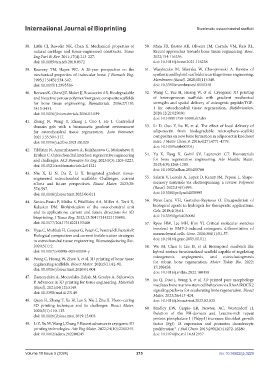Page 223 - IJB-10-5
P. 223
International Journal of Bioprinting Biomimetic osteochondral scaffold
38. Little CJ, Bawolin NK, Chen X. Mechanical properties of 50. Maia FR, Bastos AR, Oliveira JM, Correlo VM, Reis RL.
natural cartilage and tissue-engineered constructs. Tissue Recent approaches towards bone tissue engineering. Bone.
Eng Part B: Rev. 2011;17(4):213-227. 2022;154:116256.
doi: 10.1089/ten.teb.2010.0572 doi: 10.1016/j.bone.2021.116256
39. Keaveny TM, Hayes WC. A 20-year perspective on the 51. Wasyłeczko M, Sikorska W, Chwojnowski A. Review of
mechanical properties of trabecular bone. J Biomech Eng. synthetic and hybrid scaffolds in cartilage tissue engineering.
1993;115(4B):534-542. Membranes (Basel). 2020;10(11):348.
doi: 10.1115/1.2895536 doi: 10.3390/membranes10110348
40. Rezwan K, Chen QZ, Blaker JJ, Boccaccini AR. Biodegradable 52. Wang C, Yue H, Huang W, et al. Cryogenic 3D printing
and bioactive porous polymer/inorganic composite scaffolds of heterogeneous scaffolds with gradient mechanical
for bone tissue engineering. Biomaterials. 2006;27(18): strengths and spatial delivery of osteogenic peptide/TGF-
3413-3431. 1 for osteochondral tissue regeneration. Biofabrication.
doi: 10.1016/j.biomaterials.2006.01.039 2020;12(2):025030.
doi: 10.1088/1758-5090/ab7ab5
41. Zhang N, Wang Y, Zhang J, Guo J, He J. Controlled
domain gels with a biomimetic gradient environment 53. Li D, Guo Y, Lu H, et al. The effect of local delivery of
for osteochondral tissue regeneration. Acta Biomater. adiponectin from biodegradable microsphere–scaffold
2021;135:304-317. composites on new bone formation in adiponectin knockout
doi: 10.1016/j.actbio.2021.08.029 mice. J Mater Chem B. 2016;4(27):4771-4779.
doi: 10.1039/c6tb00704j
42. Yildirim N, Amanzhanova A, Kulzhanova G, Mukasheva F,
Erisken C. Osteochondral interface: regenerative engineering 54. Yu X, Tang X, Gohil SV, Laurencin CT. Biomaterials
and challenges. ACS Biomater Sci Eng. 2023;9(3):1205-1223. for bone regenerative engineering. Adv Healthc Mater.
doi: 10.1021/acsbiomaterials.2c01321 2015;4(9):1268-1285.
doi: 10.1002/adhm.201400760
43. Niu X, Li N, Du Z, Li X. Integrated gradient tissue-
engineered osteochondral scaffolds: Challenges, current 55. Salaris V, Leonés A, Lopez D, Kenny JM, Peponi L. Shape-
efforts and future perspectives. Bioact Mater. 2023;20: memory materials via electrospinning: a review. Polymers
574-597. (Basel). 2022;14(5):995.
doi: 10.1016/j.bioactmat.2022.06.011 doi: 10.3390/polym14050995
44. Santos-Beato P, Midha S, Pitsillides AA, Miller A, Torii R, 56. Pérez-Luna VH, González-Reynoso O. Encapsulation of
Kalaskar DM. Biofabrication of the osteochondral unit biological agents in hydrogels for therapeutic applications.
and its applications: current and future directions for 3D Gels. 2018;4(3):61.
bioprinting. J Tissue Eng. 2022;13:20417314221133480. doi: 10.3390/gels4030061
doi: 10.1177/20417314221133480 57. Ryoo HM, Lee MH, Kim YJ. Critical molecular switches
45. Vyas C, Mishbak H, Cooper G, Peach C, Pereira RF, Bartolo P. involved in BMP-2-induced osteogenic differentiation of
Biological perspectives and current biofabrication strategies mesenchymal cells. Gene. 2006;366(1):51-57.
in osteochondral tissue engineering. Biomanufacturing Rev. doi: 10.1016/j.gene.2005.10.011
2020;5(1):2. 58. Wu M, Chen F, Liu H, et al. Bioinspired sandwich-like
doi: 10.1007/s40898-020-00008-y hybrid surface functionalized scaffold capable of regulating
46. Wang C, Huang W, Zhou Y, et al. 3D printing of bone tissue osteogenesis, angiogenesis, and osteoclastogenesis
engineering scaffolds. Bioact Mater. 2020;5(1):82-91. for robust bone regeneration. Mater Today Bio. 2022;
doi: 10.1016/j.bioactmat.2020.01.004 17:100458.
doi: 10.1016/j.mtbio.2022.100458
47. Zaszczyńska A, Moczulska-Heljak M, Gradys A, Sajkiewicz
P. Advances in 3D printing for tissue engineering. Materials 59. Lu Q, Diao J, Wang Y, et al. 3D printed pore morphology
(Basel). 2021;14(12):3149. mediates bone marrow stem cell behaviors via RhoA/ROCK2
doi: 10.3390/ma14123149 signaling pathway for accelerating bone regeneration. Bioact
Mater. 2023;26:413-424.
48. Quan H, Zhang T, Xu H, Luo S, Nie J, Zhu X. Photo-curing doi: 10.1016/j.bioactmat.2023.02.025
3D printing technique and its challenges. Bioact Mater.
2020;5(1):110-115. 60. Bradley EW, Carpio LR, Newton AC, Westendorf JJ.
doi: 10.1016/j.bioactmat.2019.12.003 Deletion of the PH-domain and Leucine-rich repeat
protein phosphatase 1 (Phlpp1) increases fibroblast growth
49. Li Z, Xu M, Wang J, Zhang F. Recent advances in cryogenic 3D factor (Fgf) 18 expression and promotes chondrocyte
printing technologies. Adv Eng Mater. 2022;24(10):2200245. proliferation*. J Biol Chem. 2015;290(26):16272-16280.
doi: 10.1002/adem.202200245 doi: 10.1074/jbc.m114.612937
Volume 10 Issue 5 (2024) 215 doi: 10.36922/ijb.3229

